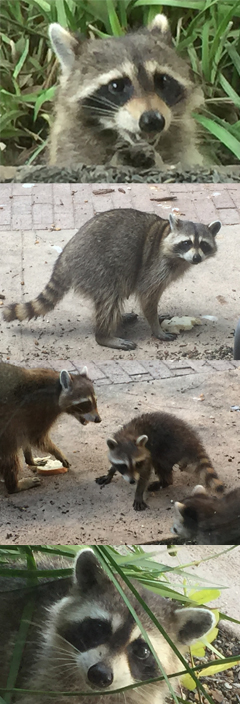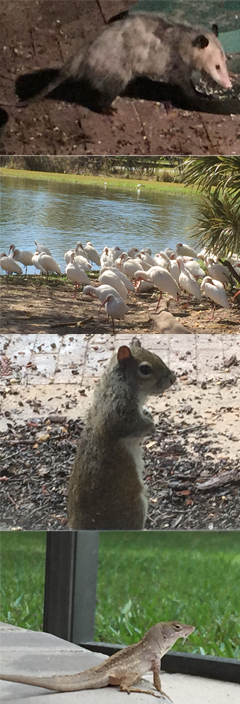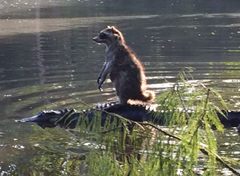 |
|||||||||||
 |
FARM, PLANTS, WILDLIFE by Mark STEWARDS OF THE LAND We also love the wildlife in Florida (the animals not the outrageous beach parties). After eight years in California with practically no animals or birds around our home, coming to Florida has seemed a bit like moving into the middle of a zoo. Florida is home to giant man eating lizards, both alligators and crocodiles are found in the swamps and marshes. We've never had either on our property but we're always vigilant when working outside. Behind our home is a pond that is about an acre in size. We had the pond stocked with fish right after we bought the place. We relied on our supplier to get us the correct balance of fish to form a viable aquatic system that pretty much maintains itself. So far it is a huge success, we have some catfish that are over two feet long now, there's also Tilapia, Bluegill, Grass Carp, Guppies and more. Softshell water turtles climb out and warm themselves in the afternoon sun on the western shore of the pond, some of these are over two-feet in diameter. Banded water snakes slither out of the pond to get warm, they swim along the shore in the evening and feed on small fish. A small Tri-Color Heron comes and feeds on small fish every day, his yellow beak and green legs provide unique contrast to his deep lavender colored wings. At night a whole new cast and crew appear. Raccoons and opossums come foraging, looking for treats in our bird feeders. A large Blue Heron feeds from the edge of the pond, stalking fish in total darkness. We've seen coyotes, wolves and deer come and eat the leftover corn we put out for the daytime ducks. By far the most interesting and intriguing guests are the wild peacocks, they come and beg for snacks every day. The peafowl spend most of their daytime hours foraging in our shrubbery for small lizards and insects. They were released into the wild over a dozen years ago when hurricanes devestated the zoo's. People who come to our property see these colorful large birds roaming around or sitting on the roof of our home and always ask "who owns those"? "They own us" is our reply. We love them, they are gentle, very quirky and extremely entertaining to watch. To see them go through their yearly mating cycle is like no other bird, that massive tail of eyeballs all comes out at the end of June and they grow a new one again starting in the Fall so they can hopefully find a mate to seduce in the spring. PLANTS We have two artesian wells on our property, I had no idea what an artesian well is until we moved here. Ours are both very deep wells, they go down over 150 feet and permeate a rock layer that pressurizes the water beneath it, this natural pressure forces the water to flow up and out of the well without a pump, you just open the tap and out comes water you can drink or water plants with. One of the artesian wells feeds our second, smaller pond which is in our agricultural area. The other artesian well is near our house and feeds the main larger pond. Bananas are Mary's other big crop plan, she has several varieties she bought online from other Florida nurseries. We've been nurturing them inside the screened-in cage over our swimming pool, this cuts down dramatically on insect damage to us and the plants during the extreme temperatures and bug population of July and August. She has begun moving strategic plants out to the agricultural area where they are watered by underwater lines fed from the artesian well. Bananas really like warmth, sun and water. WATER QUALITY OUR FARM Mary was probably a plant in a previous life, she might be partially plant now, her love for them is boundless and she enjoys nurturing them, looking at them and at times torturing them, all in the name of science. This has resulted in us having quite a few interesting and unique things growing around the place. We are both fans of tropical plants especially the varieties with massive jurassic-park style leaves. We're still testing and evaluating various crops to grow, we've got stacks of Mother Earth News magazines here for inspiration and ideas. While we love animals neither of us is drawn to raising them, we could never eat them either, we personify everything so it would be like eating a relative. Bamboo, bananas and critters are keeping us very busy right now. |
||||||||||
| Mother raccoons forage for food during the day while their babies sleep in trees. When the babies are two months old she escorts them around to all her favorite feeding places. After the babies get to six-months old they move off to find their own territory, just in time for the next batch that comes around. | |||||||||||
 |
|||||||||||
 |
 |
||||||||||
|
Raccoon surfing on an alligator
only in Florida! |
Invasive Tree Frog rescued from pool
(later learned they're toxic to handle) |
This heron can stand
up over four-feet tall |
Deer like cracked corn
they live in the woods behind us |
||||||||